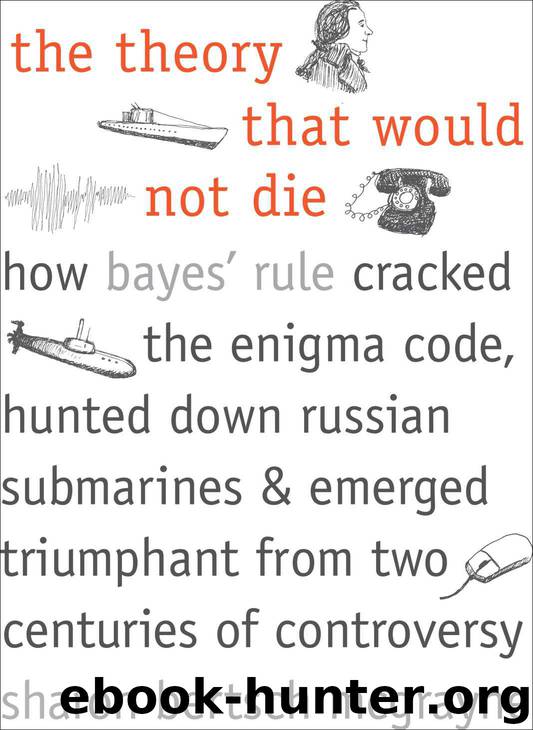The Theory That Would Not Die by Sharon Bertsch McGrayne

Author:Sharon Bertsch McGrayne [McGrayne, Sharon Bertsch]
Language: eng
Format: epub
Publisher: Yale University Press
Published: 2011-05-17T05:00:00+00:00
13.
the cold warrior
The Federalist project impressed the still small world of professional statisticians, but John Tukey, a star from the world of Cold War spying, would give Bayes’ rule the opportunity to demonstrate its prowess before 20 million American television viewers. But would the statistical community learn from Tukey’s example that Bayes had come of age? That was the question.
Bayes’ big chance at fame commenced in 1960 with the race between Senator Kennedy and Vice President Richard M. Nixon to succeed Eisenhower as president. The election was far too close to call, but the nation’s three major television networks competed fiercely to be the first to declare the victor. Winning the race would translate into prestige and advertising dollars. For the National Broadcasting Corporation (NBC), there was a bonus: the opportunity to show off the latest computers made by its corporate owner, Radio Corporation of America (RCA).
NBC’s Huntley–Brinkley Report, the nation’s top-rated TV news program, reached 20 million viewers each weeknight. Co-anchors Chet Huntley, broadcasting from New York, and David Brinkley, from Washington, were celebrities; more people could recognize them than Cary Grant or James Stewart. NBC’s fast-paced format and informal nightly sign-off—“Good night, Chet,” “Good night, David”—transformed TV news.
Despite the program’s popularity, memories of the polling industry’s spectacularly poor performances in the 1936 and 1948 elections as well as the extraordinarily close Nixon–Kennedy race made network executives nervous. In preparation for Election Day, NBC went looking for someone to help it predict the winner. In the first of a series of surprises, the network approached a Princeton University professor, John W. Tukey.
Today Tukey is best known for the terms “bit” and “software,” and few outside statistics and engineering recognize his name. But he was a man of staggering accomplishments in the cloak-and-dagger world of military research, especially in code breaking and high-tech weaponry. He worked two jobs 30 miles apart: at Princeton University, where he was a professor of statistics, and at AT&T’s Bell Laboratories, then widely considered the finest industrial research laboratory in the world. From these vantage points, he advised five successive U.S. presidents, the National Security Agency, and the Central Intelligence Agency.
To appreciate the audacity of NBC’s job offer to Tukey, one needs to understand how deeply he was embedded in Cold War secrets. He had done research on topology in the late 1930s and military analysis in the 1940s. As a young man during the Second World War, Tukey worked in Princeton with the Operations Research Group that computed how a B-29 bomber speeding over Europe should aim its machine-gun fire. With pencil and paper during the Cold War, he broad-brushed the aerodynamics, trajectory, and warhead for the Nike, the first antiaircraft surface-to-air missile system. He also helped persuade Eisenhower to build the U-2, the spy plane that flew from 1956 until 1960, the year a U-2 pilot Francis Gary Powers was shot down over the USSR.
When NBC News approached Tukey in 1960, he had been a member of the CIA’s Science and Technology Advisory Panel and the National Security Agency’s Science Advisory Board for eight years.
Download
This site does not store any files on its server. We only index and link to content provided by other sites. Please contact the content providers to delete copyright contents if any and email us, we'll remove relevant links or contents immediately.
| Biomathematics | Differential Equations |
| Game Theory | Graph Theory |
| Linear Programming | Probability & Statistics |
| Statistics | Stochastic Modeling |
| Vector Analysis |
Modelling of Convective Heat and Mass Transfer in Rotating Flows by Igor V. Shevchuk(6391)
Weapons of Math Destruction by Cathy O'Neil(6142)
Factfulness: Ten Reasons We're Wrong About the World – and Why Things Are Better Than You Think by Hans Rosling(4694)
Descartes' Error by Antonio Damasio(3230)
A Mind For Numbers: How to Excel at Math and Science (Even If You Flunked Algebra) by Barbara Oakley(3217)
Factfulness_Ten Reasons We're Wrong About the World_and Why Things Are Better Than You Think by Hans Rosling(3198)
TCP IP by Todd Lammle(3134)
Fooled by Randomness: The Hidden Role of Chance in Life and in the Markets by Nassim Nicholas Taleb(3044)
Applied Predictive Modeling by Max Kuhn & Kjell Johnson(3018)
The Tyranny of Metrics by Jerry Z. Muller(3000)
The Book of Numbers by Peter Bentley(2908)
The Great Unknown by Marcus du Sautoy(2646)
Once Upon an Algorithm by Martin Erwig(2598)
Easy Algebra Step-by-Step by Sandra Luna McCune(2580)
Lady Luck by Kristen Ashley(2532)
Practical Guide To Principal Component Methods in R (Multivariate Analysis Book 2) by Alboukadel Kassambara(2497)
Police Exams Prep 2018-2019 by Kaplan Test Prep(2483)
All Things Reconsidered by Bill Thompson III(2355)
Linear Time-Invariant Systems, Behaviors and Modules by Ulrich Oberst & Martin Scheicher & Ingrid Scheicher(2333)
